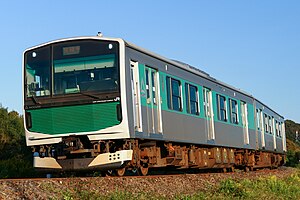| Karasuyama Line | |||
|---|---|---|---|
 An EV-E301 series BEMU on the Karasuyama Line in October 2023 An EV-E301 series BEMU on the Karasuyama Line in October 2023 | |||
| Overview | |||
| Native name | 烏山線 | ||
| Status | In operation | ||
| Owner | |||
| Locale | Tochigi Prefecture | ||
| Termini | |||
| Stations | 8 | ||
| Service | |||
| Type | Regional rail | ||
| Operator(s) | JR East | ||
| Rolling stock | EV-E301 series BEMU | ||
| History | |||
| Opened | 15 April 1923; 101 years ago (15 April 1923) | ||
| Technical | |||
| Line length | 20.4 km (12.7 mi) | ||
| Number of tracks | Single tracked | ||
| Character | Fairly rural | ||
| Track gauge | 1,067 mm (3 ft 6 in) | ||
| Electrification | None | ||
| Operating speed | 65 km/h (40 mph) | ||
| |||
The Karasuyama Line (烏山線, Karasuyama-sen) is a railway line in Tochigi Prefecture, Japan, owned and operated by East Japan Railway Company (JR East). It connects Hōshakuji in the town of Takanezawa with Karasuyama in Nasukarasuyama.
Services
Trains run approximately once every hour, traveling the entire length of the line. Some trains travel through onto the Utsunomiya Line (Tohoku Main Line) to Utsunomiya Station.
Stations
| Station | Japanese | Distance (km) | Transfers | Location | |
|---|---|---|---|---|---|
| Between stations |
Total | ||||
| Hōshakuji | 宝積寺 | - | 0.0 | JU Utsunomiya Line (Some through trains to Utsunomiya) | Takanezawa, Shioya District |
| Shimotsuke-Hanaoka | 下野花岡 | 3.9 | 3.9 | ||
| Niita | 仁井田 | 2.0 | 5.9 | ||
| Kōnoyama | 鴻野山 | 2.4 | 8.3 | Nasukarasuyama | |
| Ōgane | 大金 | 4.4 | 12.7 | ||
| Kobana | 小塙 | 2.6 | 15.3 | ||
| Taki | 滝 | 2.2 | 17.5 | ||
| Karasuyama | 烏山 | 2.9 | 20.4 | ||
Rolling stock
- EV-E301 series BEMU (since 15 March 2014)
From the start of the revised timetable on 15 March 2014, a new EV-E301 series two-car battery electric multiple unit (BEMU) was introduced on the Karasuyama Line and Tohoku Main Line between Utsunomiya and Karasuyama. Developed from the experimental "Smart Denchi-kun" battery electric railcar also tested on this line since 2012, the EV-E301 series train is recharged at a special recharging facility built at Karasuyama Station, and operates on battery power over the non-electrified Karasuyama Line tracks.
All of the remaining KiHa 40 series diesel trains used on the line were withdrawn on 3 March 2017, and replaced with EV-E301 series battery electric units from the start of the revised timetable on 4 March 2017.
Former rolling stock
- KiHa 40 series DMUs (until 3 March 2017)
History
The line opened on 15 April 1923. With the privatization of Japanese National Railways (JNR) on 1 April 1987, the line came under the control of JR East.
Wanman driver only operation commenced on the line on 10 March 1990, using KiHa 40 series DMUs.
References
- 烏山線でEV-E301系が営業運転を開始 [EV-E301 series enters revenue service on Karasuyama Line]. Japan Railfan Magazine Online (in Japanese). Japan: Koyusha Co., Ltd. 16 March 2014. Retrieved 17 March 2014.
- JR東日本 烏山線に新型蓄電池電車導入 [JR East to introduce new battery train on Karasuyama Line]. Tetsudo Hobidas (in Japanese). Japan: Neko Publishing Co., Ltd. 6 November 2012. Retrieved 6 November 2012.
- JR烏山線のディーゼル車「キハ40形」 「たらこ色」の車両ラストラン [Last run on JR Karasuyama Line for red KiHa 40 diesel cars]. Sankei News (in Japanese). Japan: The Sankei Shimbun & Sankeu Digital. 4 March 2017. Archived from the original on 4 March 2017. Retrieved 4 March 2017.
- ^ Ishino, Tetsu, ed. (1998). 停車場変遷大辞典 国鉄・JR編 [Station Transition Directory - JNR/JR] (in Japanese). Vol. I. Japan: JTB. p. 106. ISBN 4-533-02980-9.
- JR気動車客車編成表 '04年版 [JR DMU & Coaching Stock Formations - 2004]. Japan: JRR. 1 July 2004. p. 197. ISBN 4-88283-125-2.
External links
- JR East Karasuyama Line information (in Japanese)


